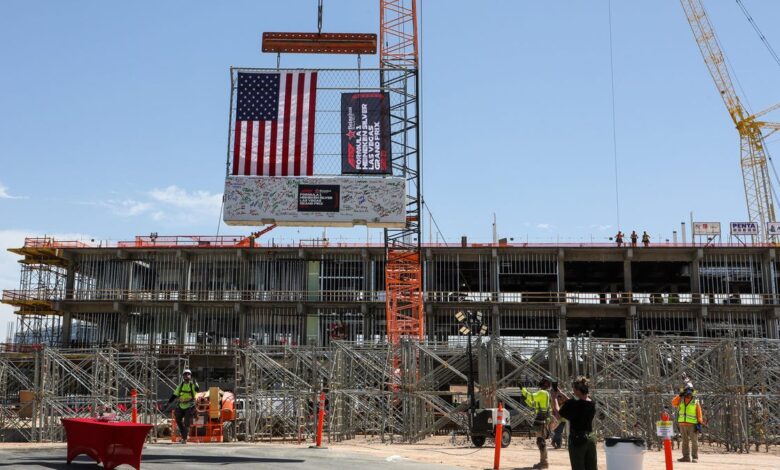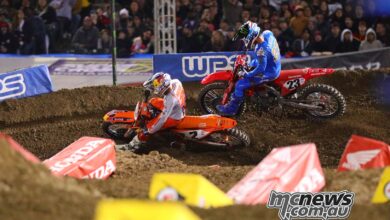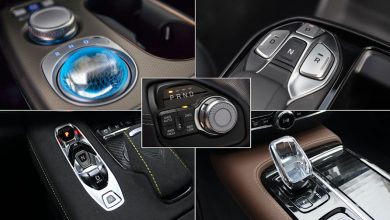F1’s Las Vegas GP Facility Isn’t Named For Stephen Paddock

Formula 1‘s Las Vegas Grand Prix weekend will be kicking off in under 80 days, and work in the city is in full swing, with roads being repaved and a permanent 300,000 square-foot paddock building being erected to house year-round F1-related activations. There’s one big problem, though: The locals think F1 has named that permanent building after mass shooter Stephen Paddock, and it doesn’t sound like F1 has done much to counter those perceptions.
I made a quick, 30-hour jaunt to Las Vegas last week to get a sense of how race prep has progressed, and I’ll admit that I was pretty impressed by the permanent facilities F1 has erected. During the race weekend, that “paddock” building will house luxury suites and hospitality; the rest of the year, F1 wants that building to serve as a year-round homage to the sport with museum exhibitions and more. It’s a formidable building just off the Las Vegas strip, and it has a ton of potential to help solidify America as a great F1 location; even if standard fans can’t afford tickets to the Grand Prix itself, they can get a taste of F1 during their Vegas vacation.
But I also know that local sentiment in Las Vegas has been mixed. I did some exploring while I was in town, heading off the beaten path to the Arts District, and as I paid for a few NASCAR die-casts I nabbed from a vintage shop, I chatted with the cashier about my reason for being in town: I was learning what makes Vegas the ideal location for F1. The cashier curled her lip, and after that, our interaction was a little more terse.
It could be easy to write that off as NIMBYism, but as I learned in the buildup to the Miami Grand Prix, locals have a much different relationship to the sudden appearance of a race track in their city than the motorsport press. I’ll admit that I giggled at the fierce opposition of Miami Gardens residents to a race track at the Dolphins stadium — until I actually did my research and realized that this community has been routinely ignored and trampled over by local governments who want to bring an attraction to Miami without actually disturbing anyone in Miami proper. I had a feeling there would be something similar at play in Las Vegas; even though many people perceive the Strip as being a location for only tourists, there are still plenty of people who live in Las Vegas who are opposing the race and feel like they aren’t being heard.
I quickly learned that’s due to one thing: the name of the paddock building.
In writing a totally different article about the permanent building, I headed to some local Vegas news websites and looked into the comment section. I’ll be honest: I was perplexed by what I saw.
“They cannot name it the Paddock building. Doing so would be completely insensitive, disrespectful, and tone-deaf. It is scheduled to open in October, for God’s sake,” one commenter wrote in an article on Casino.org.
The comments of Facebook posts linking similar local news articles struck a similar tone, with some people arguing that the definition of a paddock exclusively referred to animals. I was perplexed.
And then, very quickly, I could see the problem: Locals think that Formula 1 has named its paddock building after Stephen Paddock, the mass murderer who opened fire on a crowd of concertgoers in Las Vegas back in October of 2017.
I reached out to a few folks I know in and around F1; no one had realized the connection. For some, the backlash against the race made more sense.
In motorsport — and primarily within European motorsport circles — a paddock is the name given to the garage area, where teams park their transporters and prepare their race cars. In America, we’re more likely to just call it a garage. Vegas locals familiar with events at places like Las Vegas Motor Speedway have likely not heard the term “paddock” in this context.
This raises quite a few concerns about the way F1 engages with the local communities in which it races — namely, that it doesn’t.
While it is true that the locals upset about the word “paddock” are unfamiliar with the world of F1, it also suggests that F1 itself hasn’t done enough to inform locals about the goings-on of the race. For many people, the Grand Prix is going to be an event forced upon their city, one they have absolutely no engagement with whatsoever. And F1 itself seems to have no interest in getting to know this community, to help it understand the context of an F1 race, to hear their concerns and make accommodations. Compounding this is the fact that the building is set to open in October — almost exactly on the anniversary of the shooting itself. Even if locals don’t think F1 named this intentionally, they’re demanding the series take a look at itself and the communities in which it races to understand that perhaps there could be a name other than “paddock” that doesn’t come charged with horrific connotations.
It’s an unfortunate miscommunication on both sides, but I will admit that I’m more perplexed by F1’s lack of community engagement in this scenario. Surely interest groups have reached out to express their frustration. Surely locals have been trying to have this conversation. Surely F1 should have realized ages ago that the word “paddock” is loaded with unfortunate connotations for this particular community — and surely it could have altered the name of the building as a result.
F1 has the unique pleasure of staging events in diverse communities around the world. This miscommunication should highlight the fact that the sport can — and should — be doing more to actually understand the places in which it hosts Grands Prix. Especially if F1 presumes to race in that community for the next decade.




